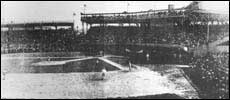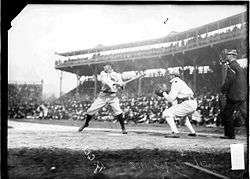South Side Park
|
| |
| Location | West 38th Place & South Princeton Avenue, Chicago, Illinois 60609 |
|---|---|
| Coordinates | 41°49′28″N 87°37′58″W / 41.82444°N 87.63278°WCoordinates: 41°49′28″N 87°37′58″W / 41.82444°N 87.63278°W |
| Capacity | 15,000 |
| Construction | |
| Broke ground | 1890 |
| Opened | 1890 |
| Closed | 1940 |
| Demolished | 1940 |
| Tenants | |
|
Chicago Pirates (MLB: PL) (1890) Chicago White Stockings (MLB: NL) (1891–1893) Chicago White Sox (MLB: AL) (1901–1910) Chicago American Giants (Negro Leagues) (1911–1940) | |
South Side Park was the name used for three different baseball parks that formerly stood in Chicago, Illinois, at different times, and whose sites were all just a few blocks away from each other.
South Side Park I (1884)
The first South Side Park was somewhere in the neighborhood of 39th Street and South Wabash Avenue, and was the home of a short-lived entry in the Union Association of 1884.
South Side Park II (1890–1893)
The second South Side Park was at 35th Street and South Wentworth Avenue, just east of the eventual Comiskey Park. It was first the home of the Chicago entry of the Players' League of 1890 (whose roster included Charles Comiskey), and then was the home of the National League team now called the Chicago Cubs during parts of 1891–1893.
South Side Park III (1900-40)

.tif.jpg)
The third South Side Park, the best known and longest lived venue by that name, was on the north side of 39th Street (now called Pershing Road) between South Wentworth Avenue and South Princeton Avenue, located at 41°49′28″N 87°37′58″W / 41.82444°N 87.63278°W. The 39th Street Grounds served as the playing field of the Chicago Wanderers cricket team during the 1893 World's Fair. After Charles Comiskey built a wooden grandstand on the site in 1900, it became the home of the Chicago White Sox of the American League. It served as home to the White Sox first in 1900 as a minor league team, and then from 1901 to June 27, 1910 as a major league team.
The team abandoned the wooden ballpark, with its capacity of 15,000, in the middle of the 1910 season after their new steel-and-concrete, and much larger Comiskey Park was finished, just three blocks north of the old park (corner to corner), where they began an 80 1⁄2 season run. Meanwhile, South Side Park became the home of the newly formed Negro League baseball team called the Chicago American Giants in 1911. It was renamed Schorling's Park for team owner Rube Foster's white business partner, John C. Schorling, a south side saloon keeper who leased the grounds and happened to be Comiskey's son-in-law.
The American Giants played their games there through the 1940 season. Then on Christmas Day of 1940, Schorling's Park was destroyed by fire. The American Giants would play their remaining 10 seasons at Comiskey Park. Today, the Chicago Housing Authority's Wentworth Gardens housing project occupies the site.
The South Side Park/Schorling's Park/Wentworth Gardens site is located across Pershing Road from a junkyard site which was named a Superfund site in the late 1990s.

World Series
It was the site of baseball's first crosstown world series in 1906. The Chicago White Sox defeated their crosstown rival Chicago Cubs in 6 games to clinch the title at home with an 8-3 victory to capture their first World Series title.
Negro National League Championships
It was the home for the Negro National League(NNL) champion Chicago American Giants in 1920, 1921, 1922, 1926, and 1927.
Negro Southern League Championship
In 1932, the Cole's American Giants won the Negro Southern League pennant.
Sources
Green Cathedrals, by Philip J. Lowry. White Sox Ballparks.
External links
- Ballparks.com
- Project Ballpark
- Searchable collection of Chicago Daily News photographs (includes many of South Side Park)
| Events and tenants | ||
|---|---|---|
| Preceded by West Side Park |
Home of the Chicago Cubs 1891–1893 |
Succeeded by West Side Park |
| Preceded by first ballpark |
Home of the Chicago White Sox 1901–1910 |
Succeeded by Comiskey Park |